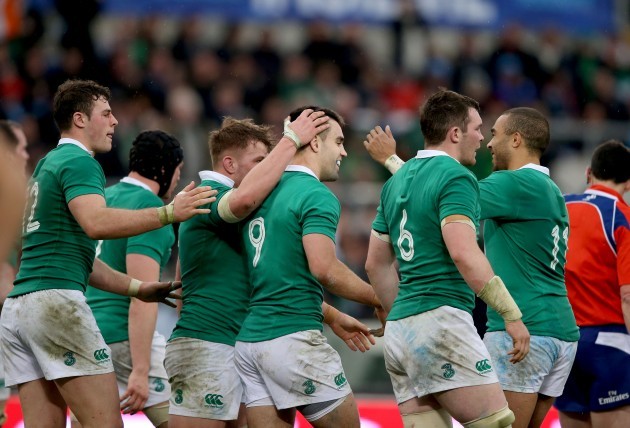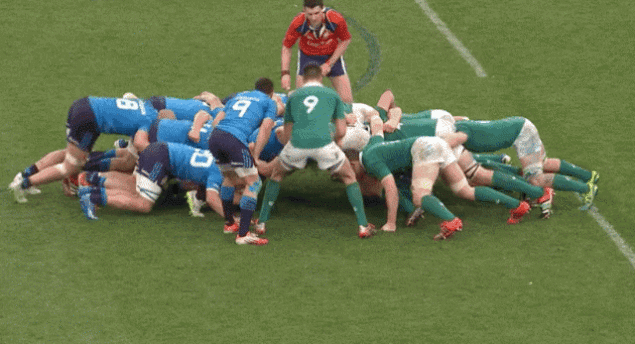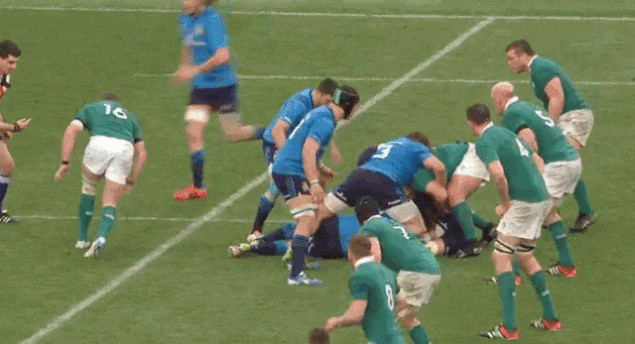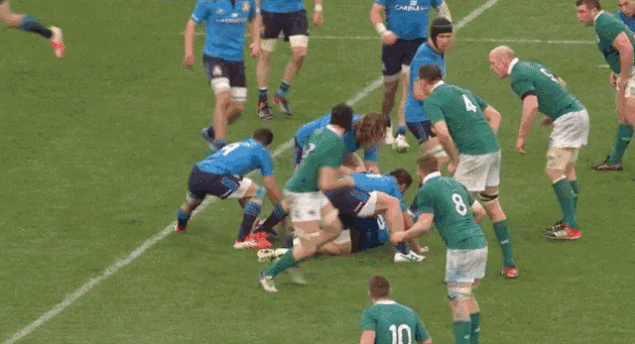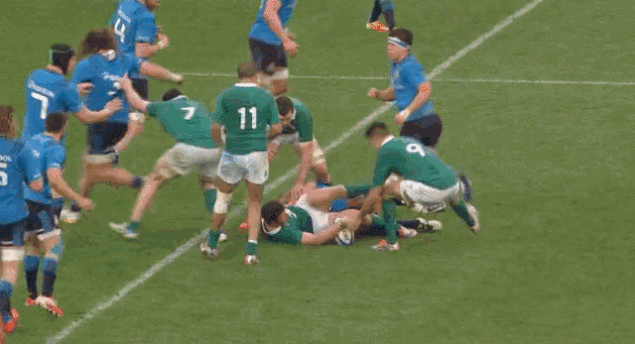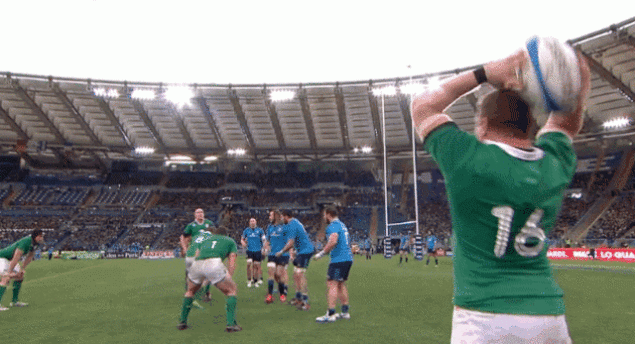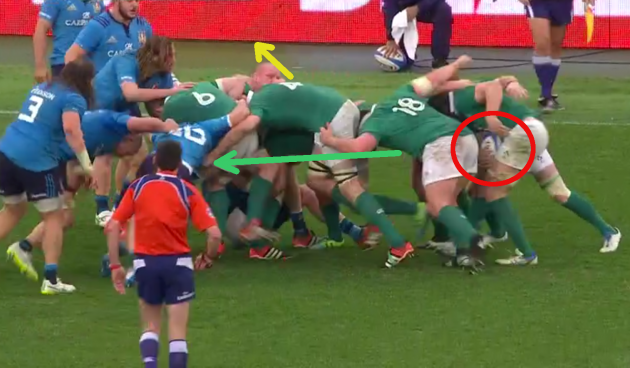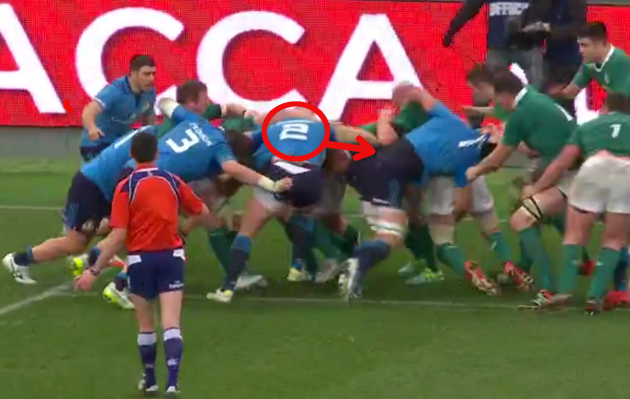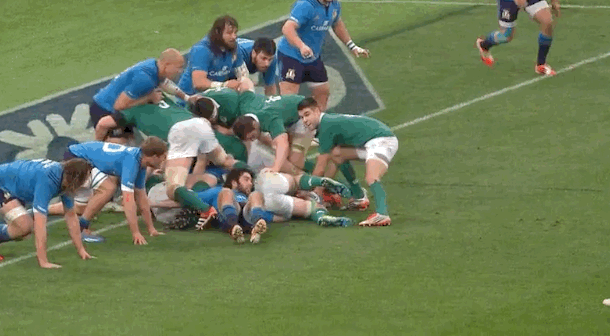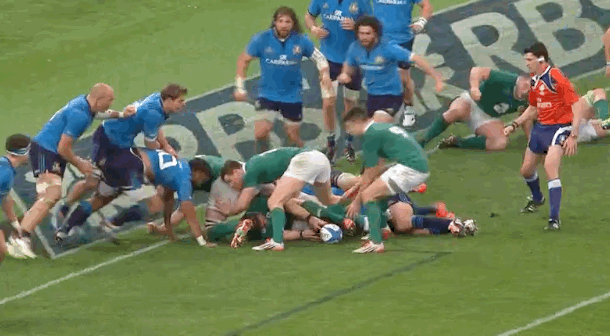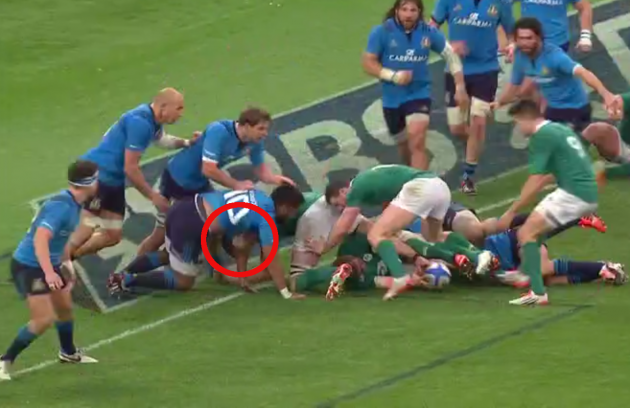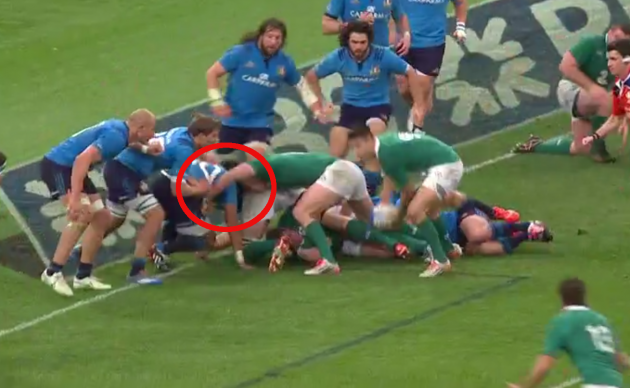THROUGHOUT THE COURSE of the Six Nations we at The42 are committed to examining each of the tries Ireland score in depth, essentially serving as a form of diary for their scoring acts.
While analysing a try in total isolation does not paint a rounded picture of any game, we can learn much about Ireland and their individual players from these moments and passages of attack.
In a sport where scoring the most points wins you the game, a five-point try is of obvious importance. The hope was that Ireland would secure more than two tries against Italy on Saturday, but both were fine efforts to get our analysis started with.
This piece focuses solely on the first, finished by Conor Murray.
Murray first on the board
Joe Schmidt’s side had to wait until the 65th minute in Rome for their first try, a delay that we will look at more closely in a later piece. It was scrum-half Murray, a clear man of the match, who dotted down for just his third international try in 31 Ireland caps.
The finish was strong from the former St. Munchin’s student, but as with nearly every score in rugby, the foundation had been laid by excellent work from Murray’s teammates.
From throw to touchdown, it takes Ireland a total of 19 seconds to score, but before we look at the important actions in the passage above, it’s worthwhile highlighting how Ireland got into this situation.
We mentioned above the danger of analysing tries in isolation and in this regard, it doesn’t make any sense to do so. If we’re going to understand the try, we need to examine where and how it came about, not just the final actions involved in forcing the ball beyond the tryline.
It All Started with a Kick
In that regard, we shift five minutes backwards in the game to a kick by Ian Keatley with 59:36 on the clock.
Ireland have the put-in to a scrum just past their own 10-metre line, with Murray feeding. It’s a superb effort from the front row of Jack McGrath, Sean Cronin and Marty Moore, but note also the work of the back-five members of the scrum.
Scrum coach Greg Feek has built a ‘scrum first’ mentality among the forwards in Ireland’s squad, meaning that even the back rows are expected to keep their heads down and contribute to the shove.
That’s certainly notable in the clip above, with Jordi Murphy at the tail dipping and dynamically shunting forward as McGrath and loosehead lock Devin Toner get the nudge up on Martin Castrogiovanni.
From there, Murray sends a crisp, accurate pass to Keatley on his right and the out-half pulls off an accurate kick to bounce the ball into touch. An Italian throw follows from the subsequent lineout, and now it’s time for Ireland to really lift the pressure.
Sean Cronin makes a good low tackle on Sergio Parisse on first phase, before Tommy O’Donnell gets up quickly to do the same on Leonardo Ghiraldini on phase two [below].
What Italy are attempting to do is set themselves up for a safe kick out of their defensive zone, taking them out of an area of the pitch they simply don’t want to spend time in. On the flip side, Ireland’s mentality is built around putting as much pressure on the Italians in this zone as possible.
That’s what makes the oppressive and aggressive tackles from Cronin and O’Donnell so important. Every inch up the pitch Ireland deny Italy, however less dominant the Italian collision, the more difficult the exiting kick is going to be.
So proves the case here, as scrum-half Murray gets up out of the line on phase three to block Masi’s attempted clearance.
The timing from Murray is superb, as he just about obeys the offside line after starting his run early. He reads the pass from Eduardo Gori well, even if Masi’s position communicates Italy’s intentions clearly.
The kick itself from Masi – who had a nightmarish game – leaves his boot on a low trajectory, and the lateness of Murray’s raising of his arms is also key. Thunder in from a long way back with your arms up in the sky and the kicker has an important visual cue.
Murray bides his time, springs his block up at a late stage and gets contact with the ball. The rebound falls to Murphy and Ireland are now in possession. By the fourth phase of their attack, Tommy Bowe is in a really threatening position down the right-hand side.
The Ulster wing’s attempt to dink the ball beyond Masi doesn’t come off, but Ireland are left with an attacking lineout well inside the Italian 22, a prime point-scoring opportunity.
Herein lies a fine example of why Ireland and other rugby teams kick the ball out of their own half with such striking regularity. 1 minute and 26 seconds after Keatley’s kick from behind Ireland’s 10-metre line, they have an attacking lineout in the Italian 22.
Having the ball inside your own half simply isn’t worthwhile in international rugby at present. Though there are obviously a number of individual examples that could disprove that assertion, the data shows that teams who kick out of their own half regularly are successful.
Where you really want possession of the ball is inside the opposition’s defensive zone, where there is a far greater chance of scoring points.
Kick into that area, pressurise the opposition exit strategy as much as possible [whether at set-piece, the breakdown, forcing a knock-on in the collision, a choke tackle, forcing a poor kick, or a block down], regain the ball and score yourself. Simple, right?
While the process is sometimes much swifter than in the case here, or indeed can often take longer, that is essentially what Ireland do. Kick into the Italy defensive third, pressurise to produce an error and then strike with the regathered possession.
Bring Them to Their Knees
And so, Ireland find themselves in an excellent attacking position, one from which they would expect to come away with a score of some sort. As it transpires, there are 2 minutes and 25 seconds between Sean Cronin’s throw at the next lineout and Murray dotting down.
What was going on in that time?
To speak in boxing terms, Ireland were softening up the Italian defence with a series of clever, concise jabs, opening up the gap for Murray’s heavy haymaker knock-out punch.
O’Connell takes Cronin’s throw at the first lineout, getting up in front of Josh Furno really dynamically and then transferring the ball immediately to O’Donnell upon landing, the openside flanker having started in the ‘receiver’ position on the left of the screen at the start of the GIF above.
O’Connell knows Italy will look to sack him [drag him to the ground] as soon as he lands, meaning his transfer of the ball has to be swift and accurate. As we see below, that proves to be the case.
Even before O’Connell is brought to deck [off in the direction of the yellow arrow], O’Donnell has fought his way to the back of the Irish maul with the ball [red circle], keeping it far from prying Italian hands.
Ireland work the shift drive away to O’Connell’s left [green arrow] and into an area where the Italians are numerically and organisationally weak. The work of Toner thereafter is really important, as he actively spearheads the maul, engaging with Martin Castrogiovanni after Murphy has been driven away from the front.
It’s an excellent set-up from Ireland and we can see how powerfully they march forward with O’Donnell at the tail and well protected. Castrogiovanni decides to cut his losses and drags the maul to the ground.
Penalty to Ireland, and after trying a ‘free’ cross-field kick play unsuccessfully, they again return to the maul with that penalty. Simon Easterby’s pack are now up to within five metres of the tryline, and referee Pascal Gaüzère has cards on his mind after a cynical Castrogiovanni infringement.
Interestingly, there appears to be a combination of O’Connell and Toner calling in this lineout, whereas normally with Ireland it’s the Munster lock who does all the decision-making in the set-piece.
O’Connell is set up at the tail here, meaning he’s further away from Cronin and therefore less likely to be heard, but it was noticeable that Toner did do some of the calling at other time as well. A vital role, and it emphasises Toner’s importance to the Ireland lineout.
Back to the task at hand, Ireland again win clean ball from a good Cronin throw, with Toner transferring to Murphy this time and Ireland shifting off down the blindside after Italy’s initial countering drive.
Cronin and O’Donnell are the key spearheading figures in terms of the shift, allowing Murphy to follow them through, and drawing Ghiraldini into ‘swimming’ up the side of the maul.
Some might view the decision as harsh, but Gaüzère has already decided that Italy are looking to spoil here, playing the game with a negative mindset.
He’s quick to draw his yellow card and Ireland get another five-metre lineout with one less defender against them.
It’s worth quickly pointing out that Ireland’s intention was not to draw a yellow card or get dragged down; they would have been looking to directly score from both mauls above. Sometimes, these things take time though, and there was the sense that O’Connell and co. weren’t leaving without a try in this instance. So it proved.
Coming to a head
Finally, we come to the try-scoring itself. Exactly four minutes and 35 seconds after Ireland’s pack had engaged in that scrum to allow Keatley kick into the Italian half, they’re tasked with producing the goods within sight of the tryline.
A huge scrum drive, two lineouts and two mauls in between, and already with three quarters of a match played – an illustration of the physical demands of international rugby if ever there was one.
It’s a really clever move from Ireland to finish off the attacking passage, and one which highlights what the players mean when they harp on about everyone knowing their role down to the nth degree under Schmidt.
As Ireland set themselves for the lineout, there’s a brief chat between O’Connell and Toner, the later of whom then heads for the front of the formation along with O’Donnell and Murphy. Toner is the man to make the final call to hooker Cronin.
The Leinster front row delivers a perfect throw to O’Connell right at the tail of the lineout, and the Italians – like just about everybody else in the stadium – are expecting another big mauling effort.
Instead, Ireland play a clever variation, bringing the trio of O’Donnell, Murphy [who receives the ball] and McGrath around from the front of the lineout to take what is essentially a pass.
That leaves Murphy running straight into an Italian back [Luke McLean], and the number eight powers to within a metre of the tryline.
McGrath and O’Donnell hit the turnover threat of Francesco Minto, while O’Connell, Moore and Peter O’Mahony also arrive into the ruck, part of their roles in an attacking movement Ireland would have practiced and mentally rehearsed heavily.
Schmidt might be critical of the quality of the rucking in this instance, however, given that the ball for Murray is not as swift as would have been expected with that number of Irish bodies in the ruck.
Minto does a decent job of spoiling even after losing his feet, but O’Connell’s studs give him a sharp reminder of the laws of the game, and Murray moves the ball away for phase two.
Again, each Irish player knows exactly their role. Cronin is the designated carrier, while Toner is in position just to the hooker’s left to either leech onto him [bind onto Cronin and drive him into contact] or be that key first arriving player into the breakdown.
Outside the forward pair, centre Robbie Henshaw is also set and aware of his need to hit this ruck, opening the back of it for Murray and ensuring the quickest of ball. That’s exactly what happens, and then the scrum-half makes the decision to finish himself.
Outside the scrum-half, Jared Payne is beginning to run a nice direct line under the posts, while O’Mahony has worked hard to get around the corner on a shorter line to Murray’s left.
There are the pieces in place for the next portion of an attack, but Murray backs his power to score from close-range. It’s encouraging to see this from the Munster man; it’s all well and good getting close to the tryline, but teams always need someone to step up and have the balls to back themselves to score.
It’s worth pointing out the detail of the rucking from Toner and Henshaw as Murray scores too, something Schmidt and his coaches are big on.
Below, we’ve highlighted Toner grasping the shirt of Kelly Haimona, holding the Italian out-half down on the ground as best he can.
A split second later and Henshaw has wrapped a big left arm in underneath Haimona too, further preventing the Kiwi native from springing back to his feet.
The combined effect of Toner and Henshaw’s actions is to ensure Haimona is in no position to make contact with Murray. Yes, Marco Barbini is present in the ‘pillar’ position to the right of the ruck, but Haimona could have had an effect on Murray.
Perhaps he was unlikely to stop the Ireland scrum-half, but at 107kg and being fond of the contact, the out-half would certainly have made a strong effort. Instead, he’s pinned to the ground and utterly unable to affect the outcome.
Haimona briefly remonstrates with the referee, pointing to the ground where Toner and Henshaw are lying [above], but there’s not a hope in hell that Gaüzère could have spotted this as he directed his attention to the grounding of the ball.
Certainly Toner’s actions are against the laws of the game, although this is simply the way the best teams in the world operate. It’s not blatant, and Haimona might not prevented Murray from from scoring, but every little detail adds up.
